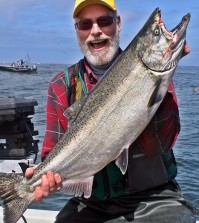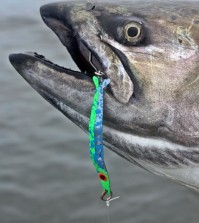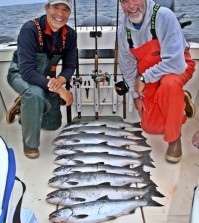Buzz Bomb Basics
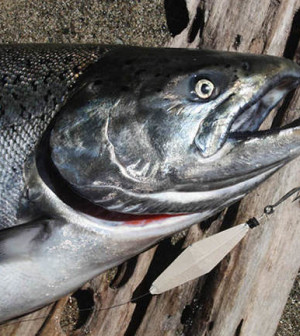
The first time I ever saw a Buzz Bomb at the end of another salmon angler’s line my reaction was something like, “You gotta be kidding me.” There was no way in the world, to my way of thinking; he was going to catch salmon on that thing. Half an hour later, as the guy casting that Buzz Bomb set the hook into his third Coho of the young morning and handed the rod off to his son, I had become a believer.
Now, nearly 30 years later, I regularly carry a dozen or more of these strange-looking lures in an assortment of sizes and colors whenever I hit the water, and consider them an important part of my salmon-fishing arsenal. Thousands of other northwest salmon fishermen feel pretty much the same way about this unique jig.
Like many of the metal, slab-type jigs that have made a name for themselves on the saltwater salmon-fishing scene, the Buzz Bomb comes to us from British Columbia. Invented by a Vancouver Island angler named Rex Field, it is now produced and distributed by his son, Doug, who also manufactures the popular Zzinger jig and Halibut Spinnow jig, both productive saltwater lures in their own right.
For the benefit of that small handful of salmon anglers who have never seen one, the Buzz Bomb is shaped like an elongated diamond and has a small hole running its full length. You run a line or leader through the hole so that the lure can ride up and down the line and spin freely.
The Buzz Bomb may look less like actual baitfish than most other metal jigs, but it’s the approximate shape and size of a baitfish, and if fished right looks like an injured, disoriented or struggling herring, anchovy or candlefish. Like all jigs, the key is to impart life into them. Remember that fish don’t have the highly developed brain that we have, and they don’t notice that a Buzz Bomb doesn’t have eyes or scales or the exact shape or color of a real baitfish. They react out of instinct, and have learned over hundreds of generations that when it comes to attacking a potential meal, if you snooze, you lose, so they hit because it just might be food.
Most of the metal jigs we use here in the Northwest are relatively heavy for their length and are intended for vertical jigging, especially for Chinook that may be found at depths of 50 to 150 feet or more. Buzz Bombs, however, are not so good for deep-water jigging, because their shape and design cause them to sink much more slowly than other jigs. Buzz Bombs are rather flat and thin, with tapered flukes that catch water and create drag as the lure falls, causing it to spin with the vibrating “buzz” for which it is named. They will catch fish when jigged vertically, but a slowly dropping jig won’t reach great depths without bellying out and going horizontal. For vertical jigging you want your lure fishing pretty much straight up and down, and a Buzz Bomb won’t do that very well at depths greater than 40 or 50 feet.
But the flat, tapered design and free-spinning action that cause the Buzz Bomb to sink slowly also make it a wildly active and enticing little morsel as it falls through the water, so it’s great for fishing the upper 20 or 30 feet of the water column. It’s an excellent lure for Coho and pinks, which are often found near the surface, as well as for Chinooks in shallow-water situations, such as estuaries and near rocky points and shallow-water break lines.
The most popular and productive technique for fishing Buzz Bombs is what I call “horizontal jigging,” a fishing method that incorporates a little vertical jigging and a little of the standard cast-and-retrieve action you might use with a spinner or wobbling spoon. It’s usually a matter of casting the lure as far as you can, then retrieving it in a series of lifts and drops. “Buzz-Bombing” can certainly be done from a boat, but it’s especially popular with shore-bound anglers because it’s a technique that allows them to reach and catch fish swimming some distance from the beach. Since spinning tackle works as well as or better than conventional casting rods and reels for this kind of fishing, even novice anglers are able to get the hang of it and start catching fish fairly quickly. When you see a lot of salmon anglers congregated along a stretch of Puget sound beach or on any of our piers and jetties during the late-summer and fall months, chances are good that many (or all) of them are casting Buzz Bombs.
As mentioned earlier, the Buzz bomb is retrieved in a series of lifts and drops, and it’s the drop that’s the most important part of the process, because you need to lower the rod tip far enough and fast enough to produce a slack line and allow the jig to go horizontal and free-fall through the water. That’s when the lure looks like a real baitfish struggling in the water and when most strikes occur. The more freely the lure falls, and the farther it drops, the more likely a fish will mistake it for an easy meal and strike it.
After the jig falls two to five feet, reel in five or six feet of line, lift the rod tip back up to the starting position, and repeat the process until the jig has been retrieved and it’s time to cast again.
As is the case with most jigging, the strike can be very subtle, because most salmon hit the lure as it’s falling on a slack line. You may detect a soft twitch in the line or even feel a little tap-tap at the rod tip, but most of the time you won’t know you’ve got a customer until you lift the rod and feel tension, which may be a couple of seconds after the fish actually took the lure. It’s important to react quickly if you think a fish may have hit, because it will already be trying to get rid of the foul-tasting chunk of metal that it mistook for an easy meal!
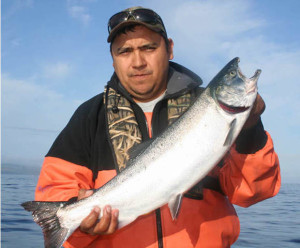 The package containing a new Buzz Bomb also includes two other components: a hook, and a rubber “doughnut” or bumper. All three are important. The bumper cushions the knot from the steady pounding of the lure bouncing up and down against it. It also serves as a bit of a bearing, allowing the lure to spin on the line more freely. If you lose the bumper, which is really easy to do because of its small size and dark-grey color, replace it with a short length of plastic or rubber tubing. Better yet, use a chunk of tubing and a small, plastic bead. Slide the bead up the line beneath the jig, then add the tubing below the bead, so that it settles down over the knot used to tied the hook on the line. That bead sitting atop the tubing acts as a bearing, allowing the lure to spin freely, while the tubing slides down over the knot and protects it from the steady pounding of the lure that’s sliding up and down against it.
The package containing a new Buzz Bomb also includes two other components: a hook, and a rubber “doughnut” or bumper. All three are important. The bumper cushions the knot from the steady pounding of the lure bouncing up and down against it. It also serves as a bit of a bearing, allowing the lure to spin on the line more freely. If you lose the bumper, which is really easy to do because of its small size and dark-grey color, replace it with a short length of plastic or rubber tubing. Better yet, use a chunk of tubing and a small, plastic bead. Slide the bead up the line beneath the jig, then add the tubing below the bead, so that it settles down over the knot used to tied the hook on the line. That bead sitting atop the tubing acts as a bearing, allowing the lure to spin freely, while the tubing slides down over the knot and protects it from the steady pounding of the lure that’s sliding up and down against it.
As for hooks, remember that the light-wire treble that comes with a new Buzz Bomb is no longer legal for saltwater fishing here in Washington. Find some other use for it and replace it with a quality siwash now that we have to use single hooks on all our salmon rigs. I’d go with something in the 3/0 to 5/0 range, depending on the size Buzz Bomb you’re using.
And keep that hook as sharp as possible. Remember that any self-respecting salmon is going to know something’s wrong as soon as it inhales that cold, metal jig, so you want sticky-sharp hooks at the business end to help get ’em stuck and keep ’em stuck. A three-sided point, with its three razor-sharp cutting edges, will allow maximum hook penetration with minimal energy, so that’s the way I go whenever I’m pointing a point on my jig hooks.
Although it may come as news to even some long-time Buzz Bomb anglers, there’s a right way and a wrong way to slide a line through this jig, and you have a 50-50 chance of rigging it upside-down. Look closely for the arrow on the lure; it shows which end is up and which end is down. If you can’t see it, you need to know that the wider, heavier end of the Buzz Bomb should be at the top, toward the rod tip, and the more pointed end points to the hook. That’s so the top of the lure drops quickly when you lower the rod tip, allowing it to get horizontal and start working more quickly. If you rig it upside-down, the butt of the jig will stay down, the lure will remain more vertical in the water, it won’t spin on its axis and won’t look as much like the baitfish it’s supposed to imitate.
Buzz Bombs can be fished effectively with 10 to 17-pound monofilament, and, of course, the lighter line you use the farther you’ll probably cast. But remember that any jig that slides up and down the line will cause some degree of line damage and lots of Buzz Bombs have gained their freedom by wearing through light monofilament and sailing off into the sunset midway through a particularly long cast. Unless you check your line frequently and re-tie those knots regularly, you might want to use an in-line swivel and a shock leader to protect against abrasion and lost lures. Use a 10 or 12-pound line for easy casting, but tie a 20-pound leader about 20 to 24 inches long below the swivel to reduce the number of jigs you lose to line wear.
I’m a firm believer in the philosophy that a jig’s action is more important than its color when it comes to attracting salmon. That certainly helps to explain why pink, chartreuse/yellow and some other non-baitfish-looking colors are among the most effective Buzz Bomb finishes. On the other hand, all those “holographic” finishes that I’ve been seeing on Buzz Bombs the past two or three years look mighty good, and my limited experiences with them have been happy ones.




